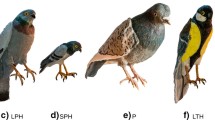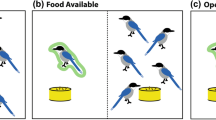Abstract
The ability to distinguish among heterospecific individuals has been reported in only a few animal species. Humans can be viewed as a special type of heterospecifics because individuals differ widely in behavior, ranging from non-threatening to very threatening toward animals. In this study, we asked whether wild magpies can recognize individual humans who had accessed their nests. We compared the behavior of breeding pairs toward individual humans before and after the humans climbed up to the birds’ nests, and also toward climbers and non-climbers. We have evidence for (i) aggressive responses of the magpie pairs toward humans who had repeatedly accessed their nests (climbers) and a lack of response to humans who had not accessed the nest (non-climbers); (ii) a total lack of scolding responses toward climbers by magpie pairs whose nests had not been accessed; (iii) a selective aggressive response to the climber when a climber and a non-climber were presented simultaneously. Taken together, these results suggest that wild magpies can distinguish individual humans that pose a threat to their nests from humans that have not behaved in a threatening way. The magpie is only the third avian species, along with crows and mockingbirds, in which recognition of individual humans has been documented in the wild. Here, we propose a new hypothesis (adopted from psychology) that frequent previous exposure to humans in urban habitats contributes to the ability of birds to discriminate among human individuals. This mechanism, along with high cognitive abilities, may predispose some species to learn to discriminate among human individuals. Experimental tests of these two mechanisms are proposed.


Similar content being viewed by others
References
Adachi I, Kuwahata H, Fujita K (2007) Dogs recall their owner’s face upon hearing the owner’s voice. Anim Cogn 10:17–21
Andersson M, Wiklund CG, Rundgren H (1980) Parental defence of offspring: a model and an example. Anim Behav 28:536–542
Blair RJR (2003) Neurobiological basis of psychopathy. Brit J Psychiat 182:5–7
Boughner RL, Thomas BL, Papini MR (2004) Effects of nonreinforced preexposure to the context on autoshaping rats: methodological implications for demonstrations of latent inhibition. Int J Comp Psychol 17:168–184
Brunton DH (1990) The effects of nesting stage, sex, and type of predator on parental defense by killdeer (Charadrius vociferous): testing models of avian parental defense. Behav Ecol Sociobiol 26:181–190
Buitron D (1983) Variability in the reponses of black-billed magpies to natural predators. Behaviour 87:209–236
Chantrey DF (1974) Stimulus preexposure and discrimination learning by domestic chicks: effect of varying interstimulus time. J Comp Physiol Psychol 87:517–525
Coss RG, Ramakrishnan U, Schank J (2005) Recognition of partially concealed leopards by wild bonnet macaques (Macaca radiata): The role of the spotted coat. Behav Processes 68:145–163
Curio E (1975) The functional organization of anti-predator behaviour in the pied flycatcher: a study of avian visual perception. Anim Behav 23:1–115
Davis H (2002) Prediction and preparation: pavlovian implications of research animals discriminating among humans. ILAR J 43:19–26
Davis H, Balfour D (1992) The inevitable bond: examining scientist-animal interactions. Cambridge University Press, New York
Dittrich L, Adam R, Ünver E, Güntürkün O (2010) Pigeons identify individual humans but show no sign of recognizing them in photographs. Behav Process 83:82–89
Domjan M (2004) Pavlovian conditioning: a functional perspective. Annu Rev Psychol 56:179–206
Dyer AG, Neumeyer C, Chittka L (2005) Honeybee (Apis mellifera) vision can discriminate between and recognise images of human faces. J Exp Biol 208:4709–4714
Edelaar P, Wright J (2006) Potential prey make excellent ornithologists: adaptive, flexible responses towards avian predation threat by arabian babblers Turdoides squamiceps living at a migratory hotspot. Ibis 148:664–671
Emery NJ (2006) Cognitive ornithology: the evolution of avian intelligence. Proc R Soc Lond Ser B Biol Sci 361:23–43
Ferrari MCO, Messier F, Chivers DP (2008) Can prey exhibit threat-sensitive generalization of predator recognition? extending the predator recognition continuum hypothesis. Proc R Soc Lond Ser B Biol Sci 275:1811–1816
Freeman GH, Halton JH (1951) Note on exact treatment of contingency, goodness of fit and other problems of significance. Biometrika 38:141–149
Gibson EJ (1969) Principles of perceptual learning and development. Appleton-Century-Crofts, New York
Gibson EJ, Walk RD (1956) The effect of prolonged exposure to visually presented patterns on learning to discriminate them. J Comp Physiol Psychol 49:239–242
Greig-Smith PW (1980) Parental investment in nest defence by stonechats (Saxicola torquata). Anim Behav 28:604–619
Grubb TC Jr (1977) Weather-dependent foraging behavior of some birds wintering in a deciduous woodland: horizontal adjustments. Condor 79:271–274
Guhl AM, Ortman LL (1953) Visual patterns in the recognition of individuals among chickens. Condor 55:287–298
Hall G (1980) Exposure learning in animals. Psychol Bull 88:535–550
Hamilton RB (1975) Comparative behavior of the American avocet and the black-necked stilt (recurvirostridae). Ornithol Monogr 17:1–97
Hemmi JM, Merkle T (2009) High stimulus specificity characterizes anti-predator habituation under natural conditions. Proc R Soc Lond Ser B Biol Sci 276:4381–4388
Herrnstein RJ, Loveland DH (1964) Complex visual concept in the pigeon. Science 146:549–551
Honey RC, Hall G (1989) Acquired equivalence and distinctiveness of cues. J Exp Psychol Anim Behav Process 15:338–346
Kazial KA, Kenny TL, Burnett SC (2008) Little brown bats (Myotis lucifugus) recognize individual identity of conspecifics using sonar calls. Ethology 114:469–478
Kendrick KM, da Costa AP, Leigh AE, Hinton MR, Peirce JW (2001) Sheep don’t forget a face. Nature 414:165–166
Knight RL, Temple SA (1986) Why does intensity of avian nest defense increase during the nesting cycle? Auk 103:318–327
Levey DJ, Londoño GA, Ungvari-Martin J, Hiersoux MR, Jankowski JE, Poulsen JR, Stracey CM, Robinson SK (2009) Urban mockingbirds quickly learn to identify individual humans. Proc Natl Acad Sci USA 106:8959–8962
Maren S (2001) Neurobiology of pavlovian fear conditioning. Annu Rev Neurosci 24:897–931
Marzluff JM, Walls J, Cornell HN, Withey JC, Craig DP (2010) Lasting recognition of threatening people by wild American crows. Anim Behav 79:699–707
McLean IG, Rhodes G (1991) Enemy recognition and response in birds. In: Power DM (ed) Current ornithology, vol 8. Plenum Press, New York, pp 173–211
Peirce JW, Leigh AE, daCosta APC, Kendrick KM (2001) Human face recognition in sheep: lack of configurational coding and right hemisphere advantage. Behav Processes 55:13–26
Redondo T, Carranza J (1989) Offspring reproductive value and nest defense in the magpie (Pica pica). Behav Ecol Sociobiol 25:369–378
Scaife M (1976a) The response to eye-like shapes by birds. I. The effect of context: a predator and a strange bird. Anim Behav 24:195–199
Scaife M (1976b) The response to eye-like shapes by birds II. the importance of staring, pairedness and shape. Anim Behav 24:200–206
Slobodchikoff CN, Kiriazis J, Fischer C, Creef E (1991) Semantic information distinguishing individual predators in the alarm calls of gunnison’s prairie dogs. Anim Behav 42:713–719
Sordahl T (2004) Field evidence of predator discrimination abilities in American avocets and black-necked stilts. J Field Ornithol 75:376–385
Symonds M, Hall G (1995) Perceptual learning in flavor aversion conditioning: roles of stimulus comparison and latent inhibition of common stimulus elements. Learn Motiv 26:203–219
Templeton CN, Greene E (2007) Nuthatches eavesdrop on variations in heterospecific chickadee mobbing alarm calls. Proc Natl Acad Sci USA 104:5479–5482
Tibbetts EA, Dale J (2007) Individual recognition: it is good to be different. Trends Ecol Evol 22:529–537
Walters JR (1990) Anti-predatory behavior of lapwings: field evidence of discriminative abilities. Wilson Bull 102:49–70
Whitfield DP (1986) Plumage variability and territoriality in breeding turnstone arenaria interpres: status signalling or individual recognition? Anim Behav 34:1471–1482
Zar JH (1999) Biostatistical analysis. Prentice Hall, Upper Saddle River, NJ
Acknowledgments
We are grateful to Changku Kang, Choongwon Jeong, Changsoo Yang, and Woncheol Song for serving as “non-climbers” and Kyungseon Seo, Jihyun Oh for participating in the work. We thank magpie team members Woohjung Kim, Giran Ko, and Yoonsook Lee for their continuing efforts on the breeding survey. We particularly thank Dr. Susan Lappan for linguistic help and Youngeun Jo, Hyunkyung Cha, and Soyon Hwang for providing data from the 2008 gaze experiment. We also thank Byungsoon Jang, Hongsup Shin, Heeyoon Kim, and Changseok Han for discussions and comments. PGJ thanks the Dean, Faculty, and Administration of the School of Biological Sciences, and especially Prof. Sa-Ouk Kang and Prof. Jung-Hye Roe for help, advice, and patience during his adaptation to life at a Korean University. This work was funded by the Long-term Ecological Monitoring Program on Animal Populations, Research Grant of 2007 from the Korean Ministry of Environment from Ewha Womans University, Korean Research Foundations grant No. KRF-0409-20090137, KRF-0409-20070120, National Research Foundation Grant No. NRF-2010-0029613, KRF-0409-20080118 and NRF-2010-K001149, NRF-2010-0009006, the Brain Korea 21 Project 2009, and Research Grants (3344-20090054, 3344-20080067, 3344-20070018 and 3344-20100051) from the College of Natural Sciences, Seoul National University.
Conflict of interest
The authors declare that they have no conflict of interest.
Ethical standards
The experiments described in this report comply with the current laws of the country in which they were performed—South Korea.
Author information
Authors and Affiliations
Corresponding authors
Rights and permissions
About this article
Cite this article
Lee, W.Y., Lee, Si., Choe, J.C. et al. Wild birds recognize individual humans: experiments on magpies, Pica pica . Anim Cogn 14, 817–825 (2011). https://doi.org/10.1007/s10071-011-0415-4
Received:
Revised:
Accepted:
Published:
Issue Date:
DOI: https://doi.org/10.1007/s10071-011-0415-4




